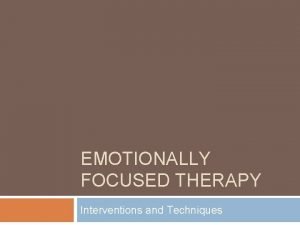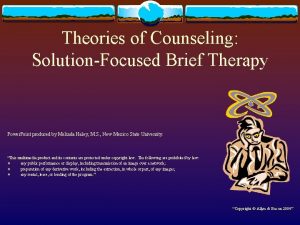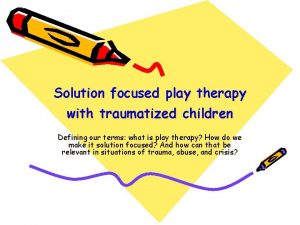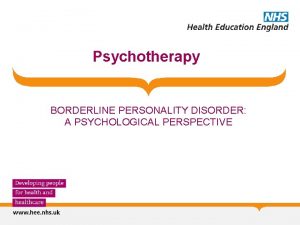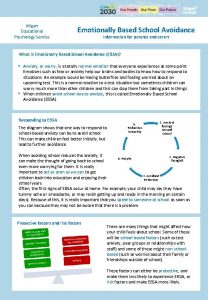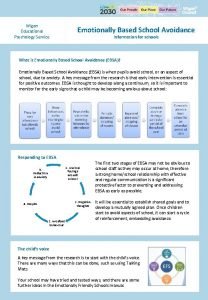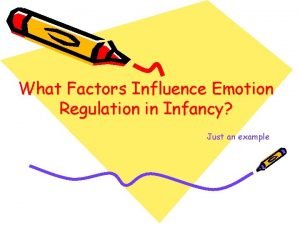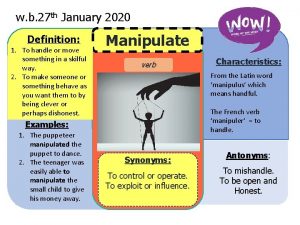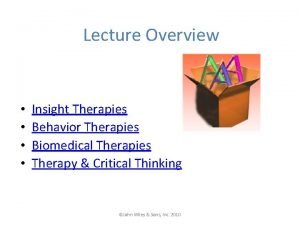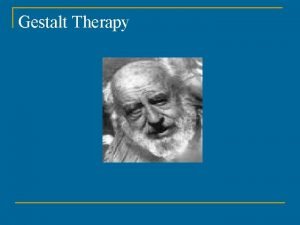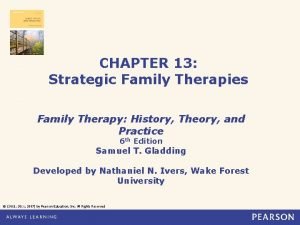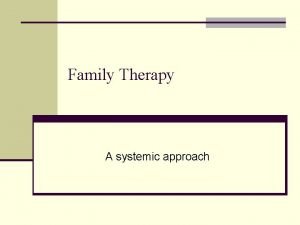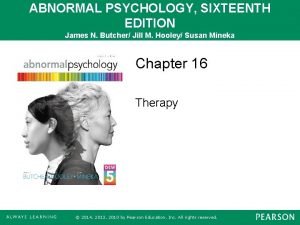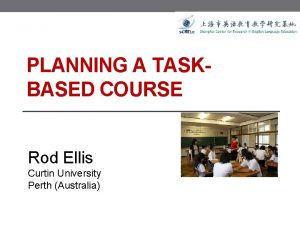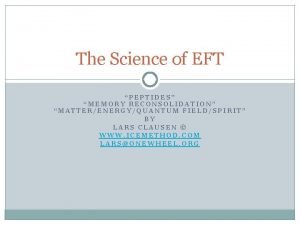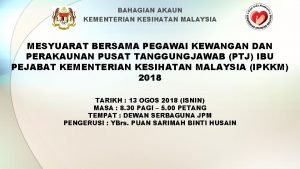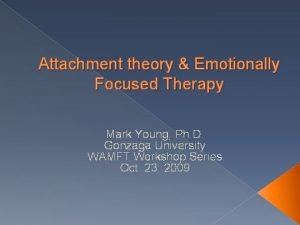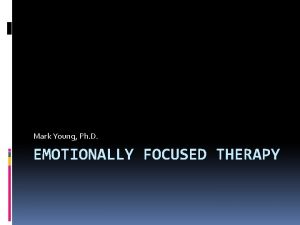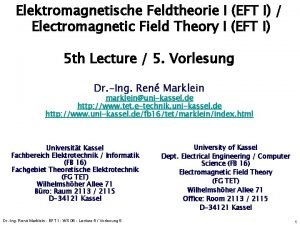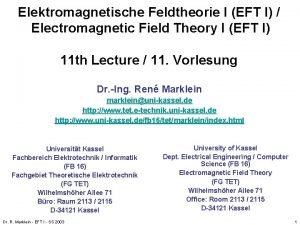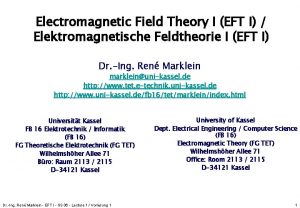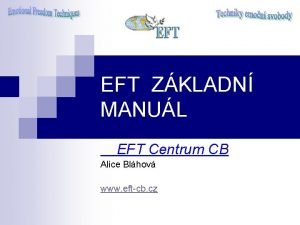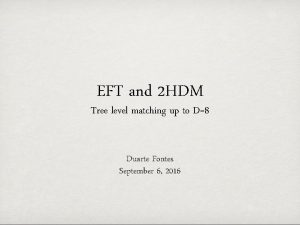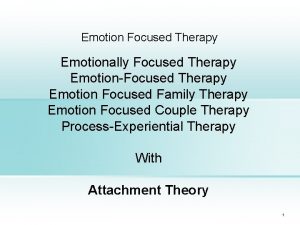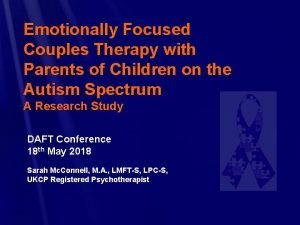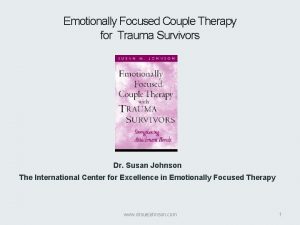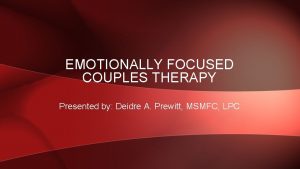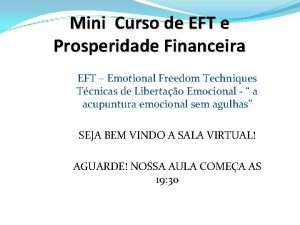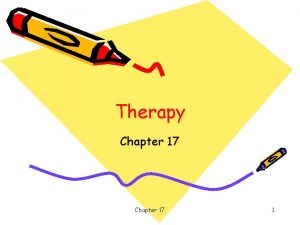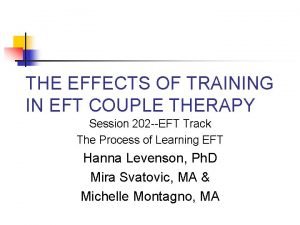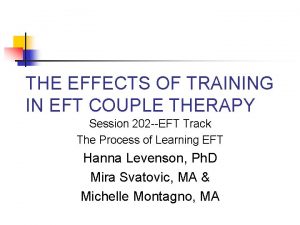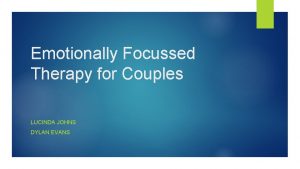EMOTIONALLY FOCUSED THERAPY Interventions and Techniques EFT Assessment






















































- Slides: 54

EMOTIONALLY FOCUSED THERAPY Interventions and Techniques

EFT Assessment Tasks 1. Create a collaborative therapeutic alliance 2. Explore client(s) agendas for: a. The relationship b. Therapy 3. Present therapy contract

4. Assess prognostic indicators a. Degree of reactivity b. Strength of attachment c. Openness or response to therapist – engagement with therapy 5. Note trust/faith of female partner

Taking History of the Relationship Sample questions: How long they have been together? What attracted them to each other? What was it like when things were good between them? When they fight/argue, do they feel they resolve issues? How do they make up? What prompted them to come for therapy at this time? What changes would they like to see?

Assessing Attachment Style Assessing Attachment History Assessing Partners’ Interactions Self-report questionnaires Individual sessions

Identifying & Delineating Negative Interactive Cycle Identifying the cycle Look for predominant pattern Delineating the cycle

Identifying & Delineating Negative Interactive Cycle Basic Negative Cycles & Interactive Positions Pursue/Withdraw Withdraw/Withdraw Attack/Attack Complex cycles Reactive pursue/Withdraw

Common Underlying Emotions of the Withdrawers and Pursuers Rejected Inadequate Afraid of failure Overwhelmed Numb – frozen Afraid – scared Not wanted or desired Judged, critized Hurt Alone Not wanted Invisible Isolated/disconnected Not important Abandoned Desperate

Key Movements in Assessment Process – Focus Points Client’s narrative is interrupted by strong affect Affect is conspicuous by its absence Personal landmark Interactional landmark Position markers Responses to positive contact

Key Movements in Assessment Process – Focus Points Client’s narrative is interrupted by strong affect Focus on emotional response Give message that it is safe and appropriate to share this experience in the session

Key Movements in Assessment Process – Focus Points Affect is conspicuous by its absence Explore lack of engagement in the personal experience being related Discover the significance in terms of the couple’s engagement in and definition of their relationship

Key Movements in Assessment Process – Focus Points Personal landmark Focus on and explore story Uncover the meaning of the story from client’s perspective Ask if the partner understands the client’s experience Label story as unresolved issue for couple and validate associated primary or secondary emotion

Key Movements in Assessment Process – Focus Points Interactional landmark Observe this interaction If alliance is developing well, refer to interaction in this session Otherwise, simply take note of the interaction

Key Movements in Assessment Process – Focus Points Position markers Get a clear picture of the position each partner takes in response to the other Ask how each partner perceives and feels about such positions

Key Movements in Assessment Process – Focus Points Responses to positive contact Explore the exit from the contact Acknowledge attempts to comfort and ability to receive comfort as a strength of the relationship

Basic Skills in Assessment Creating a therapeutic alliance – a safe haven in therapy. Empathic Attunement Acceptance Genuineness

Therapy skills used in assessment Reflection Validation Reframing & catching the bullet

Reflection Reflecting client’s experience Reflecting nonverbal communication Verbal and nonverbal communication incongruence

Validation Validating client’s experience Careful validation

Reframing Need to understand issues the clients are struggling with. Shifts focus, validates and redirects. Catching the bullet Interrupting hurtful comments/negative cycles – works to create safety

Remember the 3 Tasks of EFT 1. 2. 3. Create and maintaining a therapeutic alliance. Accessing and reformulating emotion. Restructuring key interactions.

Core Interventions Once alliance is established, there are two basic tasks Exploration and reformulation of emotional experience Restructuring of interactions

Core Interventions Exploring & Reformulating Emotion Reflecting emotional experience Validation Evocative Responding Heightening Empathic Conjecture or Interpretation

Exploring & Reformulating Emotion Reflecting Emotional Experience Focusing therapy process Building & maintaining the alliance Clarifying emotional responses underlying interactional positions

Exploring & Reformulating Emotion Validation Legitimizing responses and supporting clients to continue to explore how they construct their experience and their interactions Building the alliance

Exploring & Reformulating Emotion Evocative Responding Expanding, by open questions, the stimulus, bodily response, associated desires and meanings of action tendency Expanding elements of experience to facilitate the re-organization of that experience Formulating unclear or marginalized elements of experience and encouraging exploration and engagement

Exploring & Reformulating Emotion Heightening Using repetition, images, metaphors, enactments Highlighting key experiences that organize responses to the partner and new formulations of experience that will re-organize the interaction

Exploring & Reformulating Emotion Empathic Conjecture or Interpretation Clarifying and formulating new meanings, especially regarding interactional positions and definitions of self.

Core Interventions Restructuring Interventions Tracking, reflecting, replaying interactions Reframing in the context of the cycle and attachment processes Restructuring and shaping interactions

Restructuring Interventions Tracking, reflecting, and replaying interactions Slows down and clarifies steps in the interactional dance Replays key interactional sequences

Restructuring Interventions Reframing in the context of the cycle and attachment processes Shifts the meaning of specific responses Fosters more positive perceptions of partner

Restructuring Interventions Restructuring and shaping interactions Enacting present positions, enacting new behaviors based upon new emotional responses and choreographing specific change events. Clarifies and expands negative interactional patterns Creates new kinds of dialogue and new interactional positions – leads to positive cycles of accessibility and responsiveness

Interventions are Experiential It is all about emotional engagement We slice it thinner until we find a level where they feel secure to engage. Once they engage we can then move to other levels. Insight is not enough to change emotions/patterns

Expanding Emotional Experience Client statement: “I feel numb/empty. ” Therapist: Can we just stay there a moment? (focus on process) You feel numb. (reflection) When Mary says “…” you feel numb. (repeat in context of cycle/interaction)

Expanding Emotional Experience And they you stay silent, say nothing? (action primed by ‘numb’ withdrawal) What’s that like for you, to go numb, stay numb? How do you feel as you talk about this right now What’s happening for you as you talk about this? About going numb?

Expanding Emotional Experience How do you do that? (frames client as agent in creation of experience) That’s how you protect yourself? (conjecture about function/attachment behavior) If you didn’t do that would happen? As you say that, you clench your fist tight, like holding on. That must be hard, to feel you have to numb out all the time.

Expanding Emotional Experience That’s the way you have of protecting yourself here. You shut down, shut off, go somewhere else, go away, hide, chill out. It’s like, ‘I don’t want to feel, ’ is that it? You cant get me? And you feel like he’s not there with you? (speaking to other partner) You can’t stay and here her say “…, ” you have to go away?

Expanding Emotional Experience Can you tell here “I shut you out? ” (enactment) For you it’s like you feel so battered, so criticized that you are numb.

Key Change Events Softening Re-engagement

Softening Pre-requisites: De-escalation of negative cycle (Stage 1) Withdrawer re-engagement (Stage 2 change event) A previously hostile, critical partner accesses “softer” emotions and risks reaching out to his/her partner who is engaged and responsive. In this vulnerable state, the previously hostile partner asks for attachment needs to be met.

Softening At this point, both partners are attuned, engaged and responsive (accessibility & responsiveness) A bonding event then occurs which redefines the relationship as a safe haven and a secure base.

What counselor does in softening Heightening emotions Evoking responding Creating a new dialogue Model a secure attachment (helps take a short cut for the couple)

Levels of change in Softening She expands her experience and accesses attachment fears. Emotions tell us what we need. She engages her partner in a different way. She articulates emotional needs and changes her stance (position) in the dance. New emotions prime new responses

Levels of change in Softening He sees her differently (afraid rather than dangerous) and is pulled towards here by her expression of vulnerability She reaches and he comforts. She sees him differently. A new compelling cycle is initiated – an antidote to previous negative cycle – a redefinition of the relationship as a secure.

Levels of change in Softening They exhibit more open communication, flexible problem solving and resilient coping. Couple resolves issues/ problems (stage 3) There are shifts in both partner’s sense of self. Both can comfort and be comforted. Both are defined as “lovable”

Change Events There is a relentless focus, while helping client feel safe/supported May be more directive After a change event – validate every aspect of what they did – be specific on what they did that worked.

Contraindications of EFT Different Agendas Separating Couples Abusive Relationships Substance Abuse Depression and Other Psychiatric Illness

Impasses and other clinical issues: Attachment Injuries A betrayal of trust or abandonment at crucial moment in need. A form of relationship trauma – defines relationship as insecure. An impasse in repair process Attachment significance is key – not content. Indelible imprint – only way out is through.

Resolution of Attachment Injuries Articulate injury and impact. The other acknowledges hurt partner’s pain and elaborates on the evolution of the event. The hurt partner integrates narrative and emotion. He/She accesses attachment fears and longings. The other owns responsibility, expresses regret, while staying attuned and engaged. Relationship is redefined as a safe haven. New narrative is constructed.

Therapist Checklist: Beginning an EFT Session 1. 2. 3. 4 5. 6. 7. 8. 9. 10. What is the cycle that characterizes this relationship? What are the hypothesized or acknowledged primary emotions embedded in this cycle? What are the attachment issues/fears/needs? Where are they in the process of change in the 9 steps? The next step/task is? Are there pivotal incidents that crystallize issues, in relationship history, in session? Are there key images, definitions of self that partners use? What are the current blocks to engagement with emotions, engagement with other? Is the alliance with therapist in tact? What happened in the last session (process)? What are this couple’s strengths?

Beginning an EFT Session Check the alliance, Is it intact with both partners? How do you know? What is the main negative cycle? Who does what? What are the primary emotions underlying the cycle? What are the linked attachment fears and issues related to the cycle?

Beginning an EFT Session Where is the couple in the EFT steps? What are the pivotal incidents in the relationship which have defined the relationship as safe or unsafe? What are the key images/definitions of self and each partner? How is the cycle playing a role in blocking emotional engagement within relationship?

Beginning an EFT Session Review the highlights and processes of the last session. What are the strengths in this relationship? What are the strengths of each partner? Review the focus and direction of the session. Review steps and make a tangible therapeutic goal for the session.

EFT. CA
 Eft cycle
Eft cycle Est eft lst lft
Est eft lst lft Solution focused therapy powerpoint
Solution focused therapy powerpoint Solution focused therapy youtube
Solution focused therapy youtube Solution focused play therapy
Solution focused play therapy Compassion focused therapy
Compassion focused therapy Occupational therapy hip replacement interventions
Occupational therapy hip replacement interventions Palpation percussion auscultation
Palpation percussion auscultation Sample focused assessment
Sample focused assessment How to assess edema
How to assess edema Emotionally unstable personality disorder
Emotionally unstable personality disorder How to take care of yourself emotionally
How to take care of yourself emotionally Example of bandwagon picture
Example of bandwagon picture Edprt
Edprt Emotionally charged words
Emotionally charged words Emotionally healthy schools
Emotionally healthy schools Emotionally unintelligent
Emotionally unintelligent The problem of emotionally unhealthy spirituality
The problem of emotionally unhealthy spirituality Corporate athlete model
Corporate athlete model Mentally spiritually physically emotionally
Mentally spiritually physically emotionally Emotionally based school avoidance
Emotionally based school avoidance Emotionally based school avoidance
Emotionally based school avoidance Emotionally regulated
Emotionally regulated Manipulation definition
Manipulation definition Both psychoanalysis and humanistic therapy stress
Both psychoanalysis and humanistic therapy stress Bioness bits cost
Bioness bits cost Humanistic therapies aim to boost
Humanistic therapies aim to boost Ls&s low vision
Ls&s low vision In axial suspension which is taken as point of suspension
In axial suspension which is taken as point of suspension Biomedical therapy techniques
Biomedical therapy techniques Reality
Reality Strategic family therapy concepts
Strategic family therapy concepts Systemic family therapy techniques
Systemic family therapy techniques Samic3
Samic3 Cognitive therapy borrows many techniques from
Cognitive therapy borrows many techniques from Focused and unfocused tasks examples
Focused and unfocused tasks examples Active listening is focused and purposeful
Active listening is focused and purposeful Purposeful listening meaning
Purposeful listening meaning Njhealth horizon
Njhealth horizon Horizon nj health appeal form
Horizon nj health appeal form Quantum eft
Quantum eft Eft worksheets
Eft worksheets Proses janaan eft
Proses janaan eft Healthy emotional attachment
Healthy emotional attachment Est eft lst lft
Est eft lst lft Bangladesh automated clearing house
Bangladesh automated clearing house Generate eft file dynamics gp
Generate eft file dynamics gp Risssc
Risssc Eft i
Eft i Eft aufbau efti
Eft aufbau efti Eft aufbau efti
Eft aufbau efti Eft metoda návod
Eft metoda návod To the tree eft
To the tree eft Rissc eft
Rissc eft Matrixeft
Matrixeft
